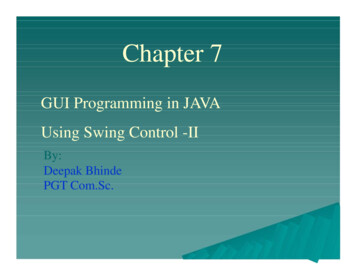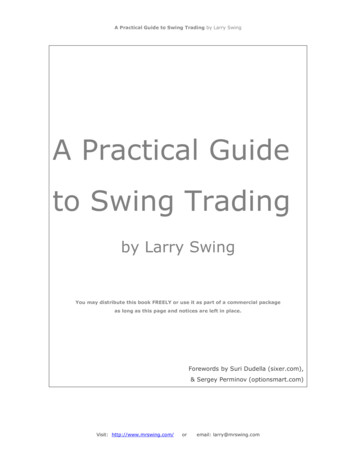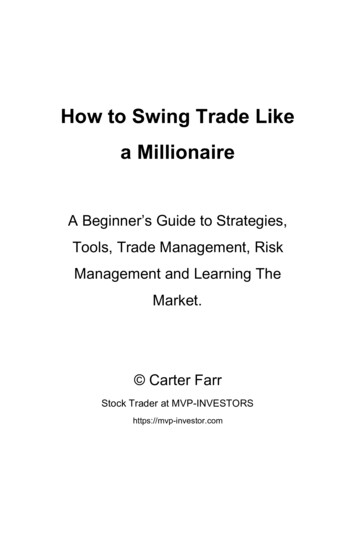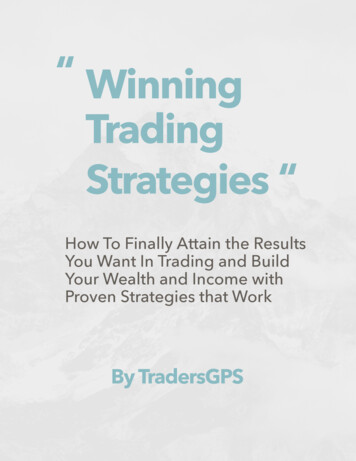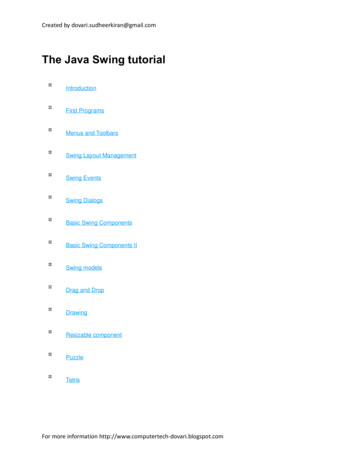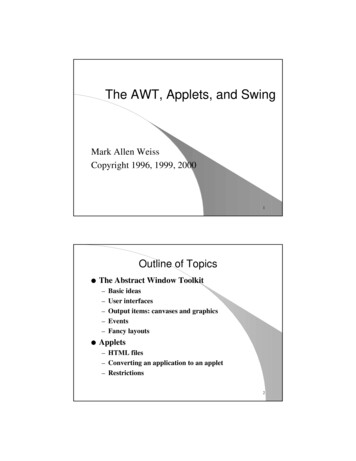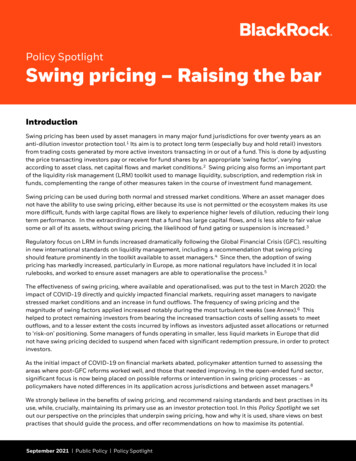
Transcription
Policy SpotlightSwing pricing – Raising the barIntroductionSwing pricing has been used by asset managers in many major fund jurisdictions for over twenty years as ananti-dilution investor protection tool.1 Its aim is to protect long term (especially buy and hold retail) investorsfrom trading costs generated by more active investors transacting in or out of a fund. This is done by adjustingthe price transacting investors pay or receive for fund shares by an appropriate ‘swing factor’, varyingaccording to asset class, net capital flows and market conditions.2 Swing pricing also forms an important partof the liquidity risk management (LRM) toolkit used to manage liquidity, subscription, and redemption risk infunds, complementing the range of other measures taken in the course of investment fund management.Swing pricing can be used during both normal and stressed market conditions. Where an asset manager doesnot have the ability to use swing pricing, either because its use is not permitted or the ecosystem makes its usemore difficult, funds with large capital flows are likely to experience higher levels of dilution, reducing their longterm performance. In the extraordinary event that a fund has large capital flows, and is less able to fair valuesome or all of its assets, without swing pricing, the likelihood of fund gating or suspension is increased. 3Regulatory focus on LRM in funds increased dramatically following the Global Financial Crisis (GFC), resultingin new international standards on liquidity management, including a recommendation that swing pricingshould feature prominently in the toolkit available to asset managers.4 Since then, the adoption of swingpricing has markedly increased, particularly in Europe, as more national regulators have included it in localrulebooks, and worked to ensure asset managers are able to operationalise the process.5The effectiveness of swing pricing, where available and operationalised, was put to the test in March 2020: theimpact of COVID-19 directly and quickly impacted financial markets, requiring asset managers to navigatestressed market conditions and an increase in fund outflows. The frequency of swing pricing and themagnitude of swing factors applied increased notably during the most turbulent weeks (see Annex). 6 Thishelped to protect remaining investors from bearing the increased transaction costs of selling assets to meetoutflows, and to a lesser extent the costs incurred by inflows as investors adjusted asset allocations or returnedto ‘risk-on’ positioning. Some managers of funds operating in smaller, less liquid markets in Europe that didnot have swing pricing decided to suspend when faced with significant redemption pressure, in order to protectinvestors.As the initial impact of COVID-19 on financial markets abated, policymaker attention turned to assessing theareas where post-GFC reforms worked well, and those that needed improving. In the open-ended fund sector,significant focus is now being placed on possible reforms or intervention in swing pricing processes – aspolicymakers have noted differences in its application across jurisdictions and between asset managers. 8We strongly believe in the benefits of swing pricing, and recommend raising standards and best practises in itsuse, while, crucially, maintaining its primary use as an investor protection tool. In this Policy Spotlight we setout our perspective on the principles that underpin swing pricing, how and why it is used, share views on bestpractises that should guide the process, and offer recommendations on how to maximise its potential.September 2021 Public Policy Policy Spotlight
Observations Swing pricing is primarily an investor protection tool. It is effective in all market conditions in whichsecurities can be fairly and appropriately valued and transacted. Swing pricing protects long term investors from transaction costs generated by the redemption andsubscription requests of other investors. First-mover advantage risk in funds arises when one investor, or set of investors, are motivated totransact ahead of others to gain a better price, negatively impacting the positions of remaininginvestors. Swing pricing does remove the first mover advantage in funds by eliminating incentives created by thefund structure for some investors to transact in advance of others. Furthermore, swing pricingincentivises investors to spread large transactions over time to reduce transaction costs. However, swing pricing is not and should not be used to change strategic allocation decisions byinvestors responding to market conditions or individual investment requirements. Swing pricing therefore does not address opportunistic or pre-emptive positioning by investors to takeadvantage of changing market conditions – which we term ‘first-mover advantage in markets’: that is,the advantage for market participants able to utilise available market liquidity ahead of other marketparticipants – this is a separate concept from first mover advantage in funds. Swing pricing therefore removes any first mover advantage created by fund structures, and leaves thefirst mover advantage in markets. This exists irrespective of investment vehicle; i.e. there is acomparatively level playing field across direct investments, investments via separate accounts, andinvestment funds. Swing pricing is suited to funds holding long-term investments that meet flows primarily by buying orselling underlying assets; it is not suitable for money market funds, for which alternative anti-dilutionmeasures are better suited; or exchange traded funds, which have built-in adjustment mechanisms . Swing pricing frequently utilises of modelling and automated data feeds, but is not automated fromstart to finish: it requires human governance and oversight, including the combined judgement andexpertise from a range of asset management functions when setting swing pricing thresholds andfactors.BLACKROCKPolicy Spotlight: Swing pricing – Raising the bar2
Recommendations We encourage continued efforts to permit swing pricing and encourage its take-up across alljurisdictions. Where local market characteristics represent barriers to implementing methods of swing pricingdeveloped to date, alternative methods of swing pricing implementation measures should beconsidered. We strongly discourage any intervention that aims to prescribe particular swing pricing models orminimum swing factors: this process requires considered judgement drawing on the skill sets ofdifferent asset management functions and should not be prescriptive. ‘Over’ swing pricing risks a pricingerror for which fund investors will require compensation; and disadvantages open-ended fund investorsvis-à-vis those using other investment vehicles by creating an unlevel playing field in their respectiveabilities to access market liquidity. Setting standards and best practises are most appropriate to regulating swing pricing. They shouldcover the principles and operations that underpin the setting of swing factors and thresholds, modelmanagement, operations, governance, and escalation procedures:– Swing factors should reflect the full range of explicit and implicit transaction costs.– The choice of full or partial swing pricing, and choice of thresholds, should reflect funds’ portfolios andinvestor base.– Models used to calculate swing factors require strong governance, oversight, and ongoing review,which should be integrated into wider fund governance.– Processes and communication channels should be in place to facilitate the flow of information andcommunication needed to determine a swing pricing decision.– Fund investors should have appropriate disclosure concerning what swing pricing is, the fact the fundutilises it, and ex-post information on how it has been used.– Bodies responsible for managing swing pricing should have tested contingency procedures in place torespond to changing conditions, and be prepared to use them.– Managers should be prepared to explain the governance and oversight of their swing pricing processand to justify the effectiveness of any models used to their regulatory supervisors. We encourage regulators to facilitate improved access to information and resources that will ultimatelyimprove swing pricing decisions, including:– The development of consolidated tapes for equities and fixed income across all markets.– Convening working groups of all participants in the fund distribution chain, with a view to improvingthe flow of critical information on underlying investor types in omnibus accounts, where not otherwisepermitted by local securities law.BLACKROCKPolicy Spotlight: Swing pricing – Raising the bar3
Swing pricing: what is it for, and what is it not for?How swing pricing worksSwing pricing is first and foremost an anti-dilution tool: it is designed to protect remaining investors in a fundfrom dilution – the cost of buying or selling securities in the fund’s portfolio to match net capital flows in or outof the fund. The process helps to ensure that investors trading in or out of a fund pay their fair share of the costof transacting in the fund’s securities, and to limit the possible dilution of remaining investors. By alertinginvestors to the costs of trading, swing pricing incentivises investors to spread large transactions over time toreduce transaction costs. Swing pricing is used on a day-to-day basis through all market conditions (seeexamples in Annex) – from calm through to stressed. Swing pricing can be deployed for as long as assets canbe fairly and appropriately valued and transacted.The application of a swing factor is separate to the process of fair valuing assets to set the fund NAV: it istherefore helpful to view the application of a swing factor as an adjustment to the fair value price which wouldotherwise apply to the fund’s assets.The ability to set an appropriate swing factor relies on the ability of the manager to assess the expected costsof transacting and accessing liquidity. However this is not necessarily dependent on accurate on-screen prices:during March 2020, for example, on-screen prices and bid-ask spreads did not always represent actionableprices. In these circumstances, the transaction cost models used to determine swing factors are supplementedby input from trading, portfolio management and risk teams to determine an adjustment that appropriatelyreflects the cost of reaching a transactable price prices.However, if underlying market conditions are so adverse that they do not support the use of fair value pricingmechanisms, swing pricing ceases to be an appropriate tool, and managers will instead use mechanisms suchas gating or suspension until market conditions stabilise.Swing factors are based on anticipated transaction costs for transacting in a portion of the fund’s assets,which we divide into explicit (e.g. taxes, levies, and broker fees) and implicit (e.g. bid-ask spreads and marketimpact) costs. Each of these will vary according to its asset class or sector, the net flows it must accommodate,and as market conditions change.Explicit costs are typically easy to measure, but vary by instrument: for equities and futures, brokers collect apre-determined execution commission; while fixed income commissions are incorporated into the final tradeprice – and can vary with market conditions. This is also true of implicit costs – transaction costs that ariseindirectly – such as bid-ask spreads and market impact, which are also influenced by the size of the orderbeing generated.Understanding and anticipating these costs and how they arise requires informed judgement, because forsome securities the line between explicit and implicit costs may be less clear. For example, an equity trading ona limit order book will have observable quotes on either side of a mid-point price, indicating the likely marketimpact and implicit cost of liquidity for a trade. By contrast, market depth for fixed income is often lesstransparent, and given the highly intermediated market structure, the cost of market liquidity will often bereflected through varying broker-dealer fees. As we discuss in section 3, this means inputs to a swing factorcannot be captured in a one-size-fits-all model and requires continual human oversight and input. Figure 1sets out in more detail the components and considerations for each swing factor component.It is noteworthy that the process of setting the adjustment occurs at a specific point within the fund’s dealingcycle, shown in Figure 2 below. The application of the relevant daily threshold and swing factors will take placeafter the cut-off point for requests to deal in shares in the fund and before the end-of-day fund price isreleased (after the assets of the fund have been valued and any adjustment for the swing factor made).BLACKROCKPolicy Spotlight: Swing pricing – Raising the bar4
Figure 1: Components of a swing factorType: explicit/ implicitComponentDescription1: Brokerage andmarket chargesFees charged byintermediaries for executinga transaction.Explicit2: Taxes, levies,and dutiesGovernment taxes onsecurities – not includingcapital gains or withholdingtaxThe difference between thebid and ask price of asecurity.Explicit3: Bid-ask spread4: Market impactBLACKROCKAdjustment for marketmovement caused bytrading activity.ImplicitImplicitInputs and considerationsFor some instruments (equities,derivatives) fees will be fixed andknown in advance; for others (fixedincome) they may vary dependingon market conditions and tradesize.Varies depending on security andby jurisdiction and whethersecurities are being bought or sold.Fund NAV in single priced funds istypically based on the mid-pointvaluation of assets, meaning thecost of ‘crossing the spread’ is notcaptured, unless through a swingfactor adjustment.9Observation of bid-ask spreadsvaries by asset class and marketstructure.Varies with market conditions andtrade size. Easier to observe forequities, less so for fixed income,where it may be captured inbrokerage fees.Policy Spotlight: Swing pricing – Raising the bar5
Figure 2: Illustrative fund dealing cycle**For illustrative purposes – timings are based on a typical European fund dealing cycle and may not be the same for all fund rangesTo be fully effective, swing factors applied should ideally reflect the full range of explicit and implicit costsassociated with a transaction, set out in Figure 1 above. This should always include market impact (see Box A),which can be a significant component of the realised cost for certain larger trades – though we are aware ofvarying approaches to this across the market. A forthcoming survey conducted by the Association of theLuxembourg Fund Industry (ALFI) found that in 2021, at least 35% of managers surveyed considered marketimpact in their swing factor calculation in normal market conditions, up from 10% in 2015. In stressed marketconditions, some managers reported moving to an ad-hoc swing pricing calculation that also included marketimpact.10Box A: Understanding market impactBid-ask spreads are an implicit transaction cost that reflect the fact that, in most circumstances, the price forbuying an instrument will be higher than for selling it to the same counterparty (i.e. a broker). However, thequantity of the security available at the best bid or ask price will not necessarily match the order size generatedby a fund. Where the order is larger, it may sometime be completed at a less advantageous price for the fund.This difference is known as market impact, and is contingent on trade size, spreads, market depth, and marketvolatility. Ex-ante assessments of market depth can be model based, judgement based, or use a combination ofboth. 11There are two main methods of swing pricing. ‘Full’ swing pricing occurs whenever there is a net flow in or outof the fund. ‘Partial’ swing pricing is triggered only when the net flow exceeds a pre-defined ‘swing threshold’.The decision to use full or partial swing pricing for a fund, and (in the latter case) which thresholds to use,cannot follow a one-size-fits-all approach, and should instead reflect the characteristics of the funds’ portfolio(assets) and its investor base (liabilities). A ‘full swing’ approach in effect means there is no threshold level ofnet capital activity to trigger the process; while a ‘partial swing’ approach will activate it once a certain level ofnet capital flows has been reached – but will make a comprehensive adjustment via the swing factor. Swingpricing does increase NAV volatility and brings a level of added operational risk and cost, so the ability to set athreshold allows managers to ensure that swing pricing is used when needed, but not on every occasion.Determining the appropriate threshold for a fund under a partial swing pricing model should reflect the desiredlevel of shareholder activity to be subject to a swing factor. The appropriateness of the threshold will thereforedepend on fund size; investor base and concentration; liquidity of its securities; and investment policy, amongother factors. Some managers, including BlackRock, have adopted a multiple threshold model which may leadto more frequent but also more graduated application of swing factors. Where a partial model is used, themultiple thresholds should again be set according to the possible range of redemptions: for example, a fundwith relatively small net flows could expect to experience only bid ask spreads upon investment/disinvestment(making a smaller swing factorBLACKROCKPolicy Spotlight: Swing pricing – Raising the bar6
appropriate), whereas as net flows increase, especially in respect of less liquid asset classes, market impactcould also be anticipated (making a larger swing factor appropriate). A multiple threshold model therefore setsthresholds and swing factors to anticipate flows of different sizes from, for example, 0.5% to over 25%.Addressing first-mover advantage in fundsSwing pricing mitigates first-mover advantage (FMA) risk in funds: that is, the risk that one investor or set ofinvestors are motivated by the structure of the fund to transact ahead of others to gain a better price. If thefund is invested in asset classes where liquidity can be shallower or variable over time, where transaction costscan fluctuate, or where prices can be slower to adjust, fund investors – in the absence of anti-dilutionmeasures – will have an incentive to redeem ahead of others, potentially reducing the value attributable toremaining investors.The greater the relative volume of investor activity in a fund, the more important the need for an effective antidilution process: swing pricing works by adjusting the price of a fund to reflect the estimated trading costs ofinvestor transactions in the price (NAV) they will receive. When applied correctly, this swing factor results in areasonable level of protection against dilution for remaining fund investors.Therefore, where investors know the fund uses swing pricing, and it is properly applied, the incentive –specifically attributable to the nature of the fund structure – to trade out of a fund in advance of its otherinvestors, is significantly reduced. Remaining investors will not bear the costs incurred by trading underlyingassets in stressed markets to meet transaction requests by other investors. We increasingly see demand fromend-investors to better understand the benefits of using swing pricing: as shown in Figure 3, the performanceuplift attributable to the use of swing pricing over time can be significant.Figure 3: Anti-dilution impact of swing pricing for representative BlackRock GlobalFunds (BGF) and BlackRock Strategic Funds (BSF)Fund rangeBGFBSFAnnual anti-dilutioneffect (bp)FundAsset classSystematic China A-Share Opportunities FundEquity24Future of Transport FundEquity21Asia Pacific Equity Income FundEquity15United Kingdom FundEquity13India FundEquity13ESG Emerging Markets Blended Bond FundFixed income11China Bond FundFixed income11Asian High Yield Bond FundFixed income10World Gold FundEquity10Global Inflation Linked Bond FundFixed income10European Diversified Equity Absolute Return FundEquity66Global Real Asset Securities FundEquity55Emerging Markets Equity Strategies FundEquity38Multi-Manager Alternative Strategies FundMulti-asset29UK Emerging Companies Absolute Return FundEquity24European Unconstrained Equity FundEquity24Global Long/Short Equity FundEquity18Emerging Markets Absolute Return FundEquity17UK Equity Absolute Return FundEquity16Emerging Markets Flexi Dynamic Bond FundFixed income16*Source: BlackRock Swing pricing: The dilution effects of investor trading activity on mutual funds (October 2020). Shows the most significant performance impact from BlackRock’sLuxembourg-domiciled BGF and BSF fund ranges from January to December 2019.BLACKROCKPolicy Spotlight: Swing pricing – Raising the bar7
The combination of funds’ pricing process and the incentives to remain invested mean that swing pricing doesnot, as some have suggested, incentivise transacting ahead of other investors. Firstly, this is because swingpricing is a business-as-usual investor protection tool, used in all market conditions – not just stressedsituations. End-investors should know and understand that swing pricing will be used when there are anymoves in or out of a fund that require it, and therefore recognise the process cannot be timed. And secondly,because fund investors’ risk of being subject to swing pricing is conceptually no different to the risk thattransacting in or out of a fund will incur a cost. The crucial difference is that swing pricing externalises theimpact onto transacting investors, thereby neutralising this specific incentive to redeem. Indeed, the operationof swing pricing provides a disincentive to transact in or out of a fund purely in order to try and avoid incurringthe cost of market impact.Box B: Stylised swing pricing exampleAs a highly stylised example, assume a 100mn fund comprised of 1,000 shares that does not use swingpricing receives five net-redemptions followed by five net-subscriptions. Each time the fund sells or buys assetsto meet these requests, there is a transaction cost borne by all non-transacting investors in the fund, reflectedin the fund NAV and share price. (A notional 50bp transaction cost is chosen here to simplify the calculation,but in practise will vary significantly by fund. BlackRock’s Luxembourg fund range typically permits swingpricing up to 1.5% for equity and multi-asset funds, and 3% for fixed income and multi asset funds).Meanwhile, a fund that has swing pricing will externalise the transaction cost through a correspondingadjustment to the share price (swung share price) received by the transacting investor. Overall transaction costsare identical in either scenario: the only difference is which set of investors incurs them.In practise, these figures will be very different and vary over time. But the principle is the same: without swingpricing, the impact of investment or disinvestment detracts from fund performance over time, whereas usingswing pricing can, over time, preserve fund performance for remaining investors.No swing pricingSwing pricingSharesredeemed (-) orsubscribed ( )Sharesoutstanding(EoD)NAV (EoD)Share Pricet-cost 5-0.510,0001010.5T BLACKROCKShare PricePolicy Spotlight: Swing pricing – Raising the bar8
Box C: Differentiating first-mover advantage in funds and in marketsAs noted above, swing pricing is a tool for managing FMA in funds generated by the potential for dilution ofremaining investors by transacting investors. An adjustment to the fund NAV reflecting transaction size andmarket conditions provides a disincentive to transact, but it cannot and should not be used to prevent investorsfrom redeeming altogether. Even when swing pricing is applied, investors can still choose to redeem for otherreasons – responding to broader market conditions, re-appraising an asset classes’ prospects, a desire to rebalance or re-allocate their portfolio, or to raise or invest cash balances. Swing pricing imposes a potential coston investors that wish to do this, but cannot and should not be used to discourage or prevent them from doingso altogether.At this point it is helpful to draw a conceptual distinction between first-mover advantage in funds – which swingpricing addresses; and first mover advantage in markets – which it does not and cannot address. There are anumber of ways to conceptualise FMA in relation to funds, and in relation to market activity more broadly. Westart by looking at definitions of FMA and their relevance to the design of swing pricing processes.The Financial Stability Board’s (FSB) recent consultation on proposals to enhance money market fund (MMF)resilience provides a definition of FMA. We believe it is a useful starting point for considering FMA in funds aswell as an assessment of FMA in markets. The FSB defines FMA as investors who redeem their shares first beingable to ‘do so on more favourable terms than investors in the same fund who redeem late for example, [if]transaction costs for assets sold to meet redemptions are not properly allocated to redeeming investors’. The FSBfurther refers to FMA occurring in ‘a scenario of declining values in fund assets, [where] investors can redeembefore the fund’s NAV adjusts to fully reflect those declines in value’; but notes that ‘[a]n investor who redeemssolely in anticipation of further market deterioration is not considered as benefitting from first-mover advantage’.This definition draws a helpful distinction between FMA in funds, and FMA in markets which reflectsopportunistic or strategic behaviours such as portfolio reallocation and rebalancing. However, more nuance isnecessary to i) further clarify the impact of FMA in open-ended funds more generally (i.e. for funds other thanMMFs and ETFs); and ii) to differentiate effects attributable solely to fund structures from first moveradvantages (such as pre-emptive or opportunistic selling) that apply across markets, and hold for all investortypes, regardless of investment wrapper. Structures such as separate accounts or investment mandates, whichare not restricted to specified dealing cut off times, can present opportunities for FMA in markets, allowingcertain investors to take up market liquidity ahead of others.FMA arises in open-ended funds where fluctuations in market liquidity or transaction costs for portfolio assetscreate the incentive for one set of investors to pre-emptively transact ahead of others and avoid paying theirappropriate share of costs incurred, whether in ordinary or volatile market conditions. Thus the first-moveradvantage in funds arises from incentives generated by the pooled investment structure which, if not corrected,can give rise to one group of investors avoiding their fair share of the cost of accessing market liquidity – to thedetriment of other investors. The scenarios in which these incentives arise are (for funds other than MMFs andETFs) best addressed by swing pricing, which takes into account both the transaction costs of providingliquidity to investors and any uncertainty around the ‘on-screen’ price of an asset.Swing pricing can manage situations where there are adverse market conditions and / or sizeable transactionsto manage, making higher transaction costs likely. In this situation the expected cost or market impact of thetrade is assessed, and the NAV is discounted by an appropriate swing factor. The fact that the transactinginvestors – who are absorbing market liquidity and generating transaction costs – are bearing those coststhemselves mitigates first-mover advantage in the fund. However, there remains a first-mover advantage inmarkets, irrespective of investment vehicle, for participants that are able to take up available market liquidityahead of other market participants.All investors, irrespective of vehicle, face incentives to transact opportunistically to take advantage perceived oractual changes in market fundamentals (such as reallocating from bonds to equity), or in market-wideconditions (such as liquidity). The fact that some investors will be able to pre-empt these changes and transactBLACKROCKPolicy Spotlight: Swing pricing – Raising the bar9
Box C: Differentiating first-mover advantage in funds and in markets (cont’d)ahead of others is an example of FMA in markets and is inherent in market functioning. This aligns with theFSB’s observation that ‘an investor who redeems solely in anticipation of further market deterioration is notconsidered as benefitting from first-mover advantage’.In summary, swing pricing was designed specifically with open-ended funds (other than MMFs and ETFs) inmind, is suited specifically for FMA in funds, and should not be altered in a way that aims to restrict fundinvestors’ ability to capitalise on FMA in markets, thereby disadvantaging them relative to investors usingalternative wrappers such as mandates or direct holdings.Box D: Applying swing pricing to money market and exchange traded fundsSwing pricing is typically applied to open-ended investment funds which, while holding some cash balances(mainly to take advantage of investment opportunities), invest primarily in assets such as fixed income orequities. Swing pricing is appropriate for these funds because a sizeable inflow or outflow creates the need totransact in underlying assets, and in turn, can generate transaction costs.By contrast, money market funds (MMFs) are designed specifically to meet redemptions through cash balances(and are required in most
Swing pricing –Raising the bar . For example, an equity trading on a limit order book will have observable quotes on either side of a mid-point price, indicating the likely market impact and implicit cost of liquidity for a trade.

